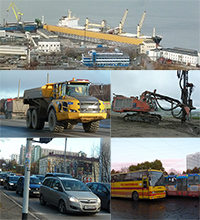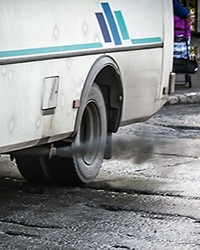Atmospher Sci & Global Chg
Research Highlights
July 2015
Scientists Estimate Soot Released from Diesel Burning in Russian Arctic
Detailed research inventory will help inform policies that could slow Arctic melting

Other sources of diesel emissions in the Arctic region provide soot that contributes to the melting of Arctic snow and ice. Immediate improvements could be gained by reducing soot particle emissions, even though soot has a relatively short life-span in the atmosphere. Photos from the brochure "Economic Benefits, Social Advantages, and Emission Reductions: Bus fleet upgrade by Murmanskavtotrans," produced by the authors.
 Diesel-fueled buses in the city of Murmansk show a visible black exhaust caused by incomplete fuel burning. Black carbon from these emissions is a powerful pollutant of concern in the Arctic, with impacts on ecosystems, climate and human health. Photo courtesy of the authors.
Diesel-fueled buses in the city of Murmansk show a visible black exhaust caused by incomplete fuel burning. Black carbon from these emissions is a powerful pollutant of concern in the Arctic, with impacts on ecosystems, climate and human health. Photo courtesy of the authors.
Results: Establishing a baseline for assessing primary sources of soot (a.k.a. black carbon) in the Russian Arctic is an important step in understanding the climatic impact of carbon pollution. Research led by Pacific Northwest National Laboratory took a detailed inventory of diesel emissions in the populous Murmansk Region.
A team from PNNL's Joint Global Change Research Institute led the detailed assessment of diesel emissions by surveying vehicles and traffic, and collecting data from other significant sources. They found that while on-road transportation is a major source of city diesel soot emissions, mining industry off-road vehicles are the largest source in the region due to both large diesel consumption and lack of emissions controls.
Why It Matters: Black carbon is a potent pollutant because of its effects on climate change, ecosystems, and human health. The impact of soot is a particular concern in the Arctic because its dark hue has the effect of absorbing more radiant energy from sunlight, changing the reflective nature of snow and ice. And by changing cloud formation, another important element is reducing the amount of sunlight that reaches Earth's surface.
Russia is by far the largest Arctic state in terms of territory and Murmansk City is the largest city in the world above the Arctic Circle. Yet, diesel emissions in this delicate environment are generally poorly understood and represent a critical gap in our understanding of the global black carbon emissions picture. This study aimed to fill this gap. Reducing diesel soot pollution in the Arctic could produce a greater slow-down of Arctic warming than reducing other longer-lived pollutants.
Methods: Researchers from PNNL and their collaborators developed a detailed inventory of diesel sources including on-road vehicles, off-road transport (mining, locomotives, construction and agriculture), fishing, and diesel generators.
The team conducted several surveys of on-road transportation to understand the vehicle fleet and driving patterns. Data from these surveys were coupled with publicly available local data sets and analysis. Regarding off-road vehicles, the team used statistical data as well as public information from annual corporate reports and other public sources.
PNNL scientists also used public data from Russian ship registries and port calls to calculate emissions from fishing vessels, various cargo ships, tankers, passenger ships, and support ships.
It is possible to substantially reduce black carbon emissions across the diesel sector. Based on best practices, the team has developed a number of policy recommendations for reducing diesel-based soot emissions. Their study also documents emission reductions resulting from a bus-fleet upgrade in Murmansk City.
The project is one of several projects for the U.S. Arctic Black Carbon Initiative. Other projects prepared emissions estimates from agriculture and forest fires and from the power sector and industry. All three efforts were funded originally by the U.S. Department of State.
What's Next? The PNNL team will work on a nationwide inventory of Russian diesel black carbon emissions. The data will enhance our understanding of Russian diesel sources and the magnitude of diesel emissions. Developing a detailed black carbon-emission inventory from diesel sources will provide a data set for modelers to improve the quality of regional and global models.
Acknowledgments
Sponsors: The U.S. Department of State with the Environmental Protection Agency, and the Office of International and Tribal Affairs
Research Team: Meredydd Evans, Nazar Kholod, and Sha Yu, PNNL; Vladimir Malyshev, Svetlana Tretyakova, Eugene Gusev and Alexander Barinov, the Murmansk State Technical University, Russia. The Joint Global Change Research Institute (JGCRI), located in College Park, is a partnership between PNNL and the University of Maryland.
Research Area: Climate & Earth Systems Science
References:
Evans M, N Kholod, V Malyshev, S Tretyakova, E Gusev, S Yu, and A Barinov. 2015. "Black Carbon Emissions from Russian Diesel Sources: Case Study of Murmansk." Atmospheric Chemistry and Physics 15: 3257-3284. DOI: 10.5194/acp-15-8349-2015
Kholod N, V Malyshev,O Lipka, E Gusev. 2015. "Economic Benefits, Social Advantages, and Emission Reductions: Bus Fleet Upgrade by Murmanskavtotrans." The Arctic Council.
Related Highlights
Project Won to Lead Black Carbon Research in the Russian Arctic